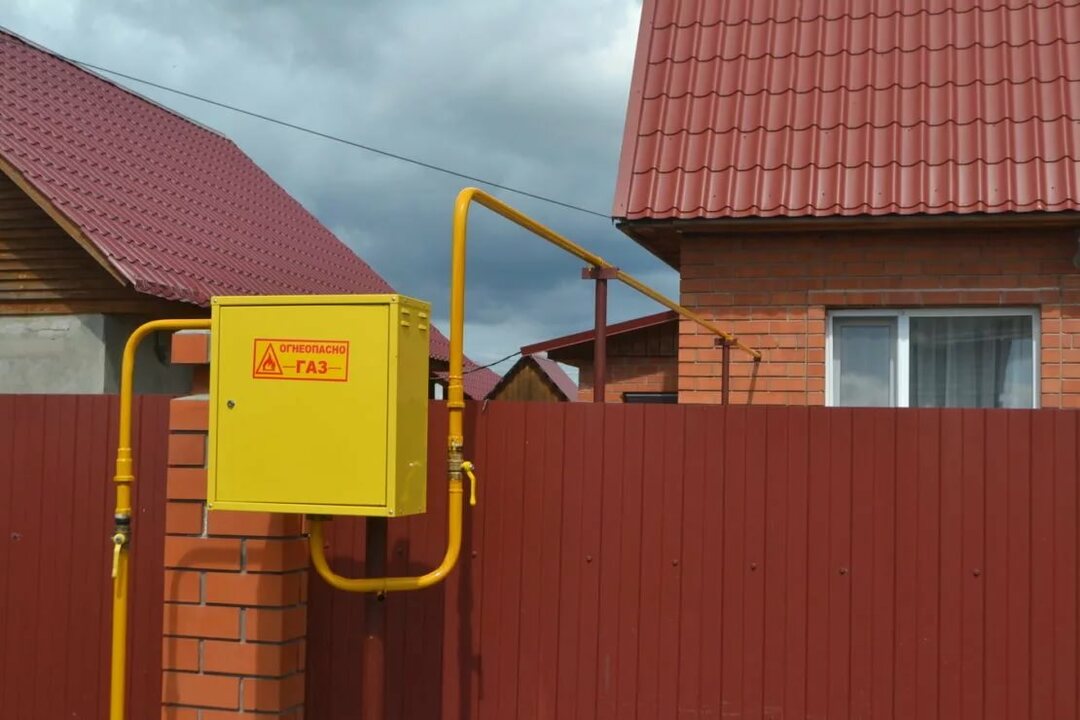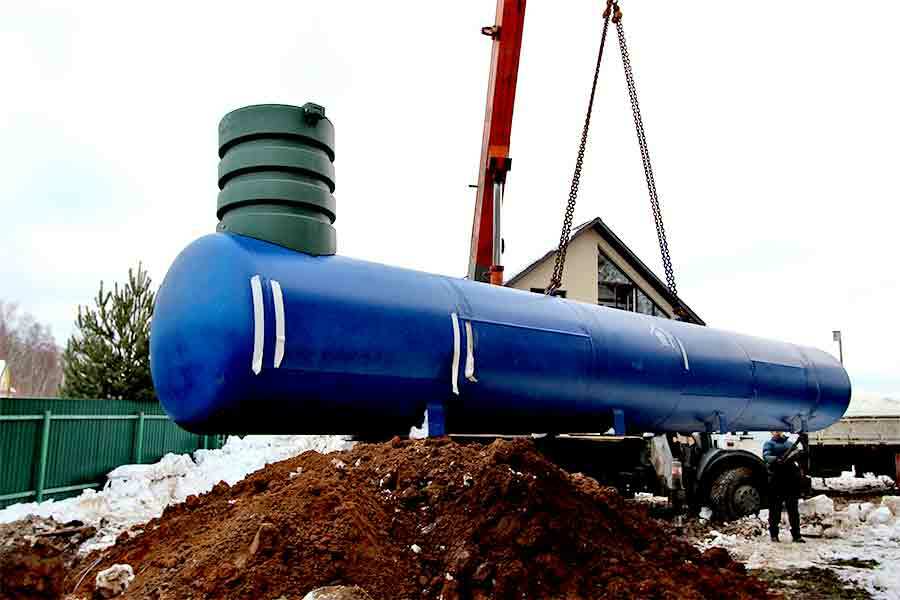Every owner wants a newly renovated or built-on attic to become one of the favorite places in the house, doesn't it? However, this room can be too hot in summer and cold in winter. The air can become stagnant, get a musty smell, and the interior decoration can be affected by mold.
The reason for such annoying phenomena is the ineffective ventilation of the attic in a private house, which was poorly designed during construction. We will tell you how best to arrange it. We will help you find errors in your system and offer several options for proven solutions.
In our proposed article, you will find a detailed description of the causes and consequences of improperly organized or unproductive ventilation. Learn how to better ensure stable air exchange. You will understand what constitutes perfect ventilation.
The content of the article:
- Types and purpose of attic ventilation
-
Ventilation of the attic room
- Supply ventilation organization
- Exhaust through the pediment
- Ventilation outlet through the roof
- Air exchange in a cold attic
- Competently arranged attic roof
- Conclusions and useful video on the topic
Types and purpose of attic ventilation
The attic floor often has a non-standard shape and layout, because there are many options for solving both the shape of the roof and the arrangement under it. Ventilation in each specific version is different, as are the temperature conditions and the possibility of outputting communications.
The most common and acceptable in terms of technical requirements layout is a sloping gable roof. Below it is a room of a regular square or rectangular shape and three cold triangular segments of the attic.

There are many options for arranging the attic space. Sometimes the entire space under the roof is made residential, leaving open the crossbars and the inner crate of the slopes. The room turns out to be spacious and airy, but it is more difficult to arrange
The living space, attics, gable cladding, and the roof also need ventilation.
For its organization are used:
- Metal, plastic or corrugated pipes and transitions for ventilation ducts;
- Dormer windows built into ramps and gables;
- Overhead, duct and roof fans;
- Deflectors installed on aerators and ventilation pipes;
- Linear and point aerators;
- Soffits that provide an inflow into the attic space and layers of the roofing system.
- Ventilation gaps between the layers of the roofing cake.
Air circulation in a residential attic is especially important, since temperature fluctuations and high humidity are possible in this room.
It can be organized in the same way as in any other room, or in a non-residential attic. The choice of the scheme depends on the purpose of the attic: for permanent or periodic residence, as well as on its layout.
Even with good ventilation of the living space, mold can appear on the walls and ceiling. The reason for this is the stagnation of humid air in the cold attic triangles that separate the wall and ceiling from the roof slopes.
As a rule, their ventilation is the easiest and cheapest to organize, but this must be remembered even before the structures and finishes are affected by black mold.
Roof ventilation consists in air circulation inside the roofing cake, from the overhangs to the ridge. It removes fumes and condensation, and also normalizes the temperature under the roof, which, according to the norms, can exceed the street maximum by 4 degrees.
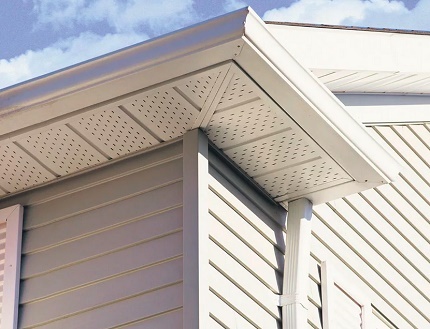
For ventilation, you do not need to give up the roof filing - there are special perforated grilles - soffits, and lattice segments can be cut into the finished hem, but it is better to leave gaps between the planks for ventilation
This ensures the safety of wood in the roof frame and metal roofing material, prevents the appearance of foci of rust and decay.
In addition, ventilation equalizes the air pressure under the roof and above it in strong winds. This significantly reduces the lifting force that tears off the roof. The ventilated facade also ensures the safety of the batten material and insulation under the cladding.
Ventilation of the attic room
The living area of the attic itself needs regular and high-quality ventilation, especially if this is a place of permanent residence, and not a country house. The air exchange rate for a room is 2 - 3 times the complete air renewal per hour, but if there is a bathroom or kitchen under the roof, the multiplicity factor increases to 8 - 12.
For the normal functioning of ventilation, it is necessary to provide paths for air intake and exhaust, approximately equal in terms of throughput. In the attic, as a rule, it is necessary to take care not only of exhausting the exhaust air, but also of the inflow of fresh air - an open staircase will not be enough.
In addition, it should be taken into account that the length of the air duct led out through the roof is less than that of the ventilation of the 1st floor, and therefore the natural draft is much lower.
Supply ventilation organization
Even the most powerful hood will not be able to work efficiently if there is nowhere to get fresh air. To do this, it is necessary to provide holes in the attic through which a fresh portion from the street can freely penetrate.
Sources of inflow can be dormer or dormer windows in slopes, ventilation windows located in opposite gables or ordinary barred openings, supply wall valves. They can be fitted with diffusers to regulate the flow.
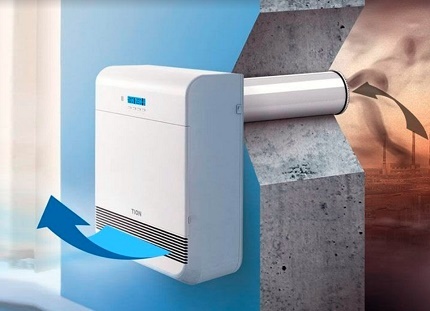
For efficient ventilation of the attic space, it is better to use a breather. It includes an air filter, mosquito net, heating, allows you to adjust the air supply or completely shut it off, change the direction of flow in the room
An elementary supply ventilation device looks like a round grill cut into the wall through a pipe. They are used where ventilation through windows is impossible or insufficient.
Air is drawn into the valve naturally, due to the pressure difference, passes through the structure that absorbs the flow noise, and is fed into the room. There are also universal supply and exhaust valves that allow air to pass in both directions.
A supply valve with a built-in fan is required to create a forced supply of fresh air. This is especially convenient and effective for mansards with complex geometric shapes. Thanks to him, pressure will be created in the room, which will independently displace the exhaust air, leaving no stagnation zones.
As a rule, supply models of ventilation valves are installed directly above the battery so that the incoming air can immediately heat up. In addition, do not mount the air inlets too high, otherwise the air will circulate only under the ceiling.
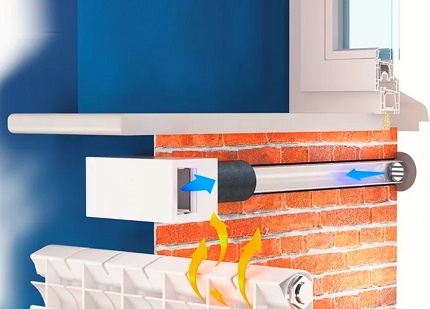
It is not difficult to install the supply valve with your own hands, the main thing is to choose the right place and find or rent a drill with a diamond core for a mobile drilling rig or a similar nozzle for drill
Dormer windows are ventilation openings closed with blind or hinged sashes with glazing or louvred grilles. The role of dormers can also be played by ordinary windows with double-glazed windows, if they are regularly opened or equipped with ventilation valves.
The easiest way is to cut windows into gables, and this is usually done in small and medium-sized houses with gable roofs. Then the air circulates both directly between the two gables and is removed by ventilation through the ceiling.
However, not any roof design implies the presence of gables, and with a large area of \ u200b \ u200bthe room, windows only at the ends will not be enough. In this case, dormers are inserted into the roof or built in dormers.
Panoramic windows cut directly into the slope, at an angle, continuing the plane of the roof. They give a lot of light, they can be installed in an already assembled roof without dismantling it. Such windows fit well into the exterior of any style, and their relatively high cost is compensated by the lack of costs for additional roof structures.
Although this is the most popular solution, it has disadvantages: panoramic dormers are prone to leakage, especially in budget options or if installed incorrectly.
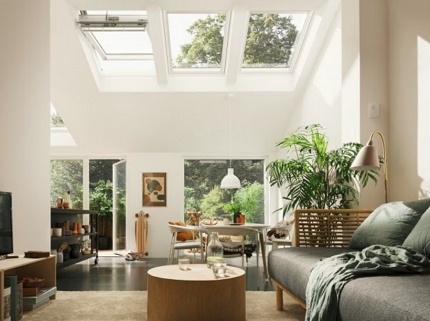
Opening panoramic windows for ventilation may be inconvenient due to the high location, and it will also not work to ventilate in rainy weather
In addition, skylights can be used for ventilation. True, this is possible if they are equipped with opening transoms. These structures will serve not only to improve natural lighting, but also to remove household fumes, smoke, exhaust air.
Dormer - these are small ledges - "houses" on the roof for the installation of ordinary, vertical windows. Such "cuckoos" make the roof more beautiful and increase the internal space, in addition, a standard window with a window sill is added to the attic.
Myself dormer can be of different shapes and configurations:
- Triangular - with a gable roof at an angle of 64 degrees, descending to the main roof. Looks the most organic in most cases.
- Square - with two vertical walls and a pitched roof, the easiest to build and allows you to install a rectangular window. And also with small vertical walls and a gable roof - in such buildings it can be difficult to waterproof the joints of the walls and the main roof;
- Arched - with a rounded roof. One of the most difficult to arrange, but only this option looks good on a rounded roof with a soft roof.
Also, ventilation will provide an antidormer - a window "recessed" in the roof. This design is cheaper, but the installation uses indoor rather than outdoor space. Especially popular on steeply sloped roofs such as broken ones.
V dormers most often, glazed windows are installed, which, in addition to ventilation, will provide both lighting and the ability to exit to the roof.
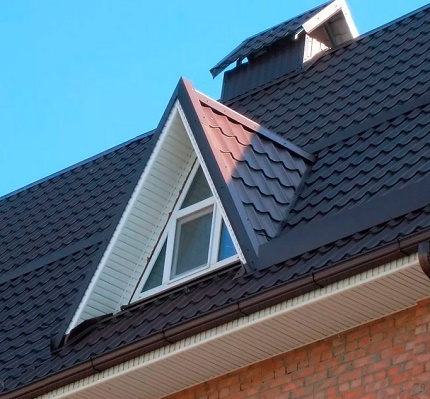
If necessary, you can sew up the wall of the dormer's gable and install a lattice dormer window through which only air will flow
Arrangement dormer - the best solution for a large attic or under the floorhip Danish roof. However, they cannot be installed on gentle slopes, with a slope of less than 350. It is also undesirable to direct the windows to the north - it will be both dark and cold.
If we talk about sizes and margins, it is not recommended to use windows smaller than 120x80cm. You should also not install them lower than 1m from the floor of the veranda or closer than 80cm from each other. For ventilation to be effective, windows, or rather, their opening parts, should be 80 - 100 cm from the ceiling or roof.
Equip the sash in dormers necessary at the design and roofing stage of the roof. When drawing up a roof plan, recalculate the total width of the windows - it should be no less than half the length of the attic. Also check that the vertical part dormer was located exactly above the outer wall of the house, and its frame could be fixed on the main rafters without cutting into them.
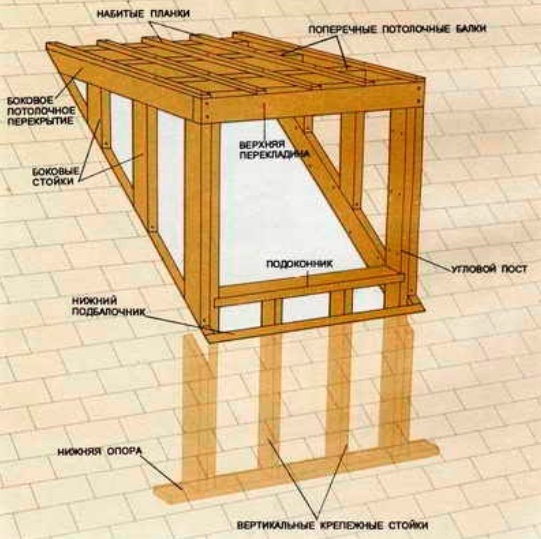
The easiest way is to build a square dormer with a pitched roof with a minimum slope. The main thing is to qualitatively insulate the joints with the main slopes.
Regarding the relationship with the rest of the windows of the house, dormers positioned exactly over the windows of the previous floor - this is both beautiful and safe.
Exhaust through the pediment
If there are gables in the house, through them it is necessary to equip not only supply ventilation, but also an exhaust hood. It is always easier and cheaper to make a hole in them than in the roof, but this is not always permissible.
Firstly, this option is probably not suitable for those who have absolutely all the space under the roof - with open crossbars and without a cold attic on top. The reason is simple: there is nowhere to lay the ventilation duct, and the hoods directly on the pediment will be enough unless for a very small one-room attic.
Secondly, it is advisable to avoid horizontal channels for those who have a bathroom or kitchen under the roof: these premises need a powerful hood, and moisture and soot from them can be collected by condensation in the attic, inside ventilation ducts and at its end, on the facade of the house.
The result is that the condensate freezes in the attic and in the chimney, and the insulation, the attic ceiling and the facade are poured into the thaw.
If you are equipping a living room in a well-insulated attic, and there is a cold triangle above it, although the minimum height - effective ventilation of the attic is possible, brought out through the gables, and not through the roof.
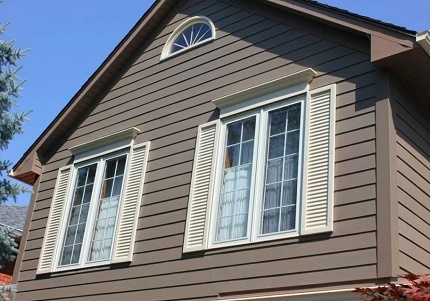
Depending on the shape of the roof, the need and the design solution, both glazed and lattice skylights can be built into the pediment
The best device diagram is organized as follows. In each living room or at the farthest point from the air supply (if there is only one room), a hole is cut in the ceiling. The grille is installed in this hole and the outlet ventilation ducts - corner or tee.
In the attic, all these holes are connected by a ventilation duct. At the same time, a check valve is installed on the branch for each room, and the passage of the channel through the outer wall is surrounded by check valves.
Desirable in the last part ventilation pipe, after connecting all parts, install a duct fan for forced operation of the hood. To minimize the formation of condensation due to temperature differences, all pipes of the ventilation duct are insulated.
It is undesirable to bring ventilation to the street flush with the facade: perhaps the protruding pipe does not look very aesthetically pleasing, but the condensation drips on the pediment will be even worse. Also, the pipe outlet must be closed with a special visor - a front exit.
Insidious arrangement hoods through gables from the attic space is that the construction of a high-quality system according to all the rules will cost almost the same amount as the output through the roof.
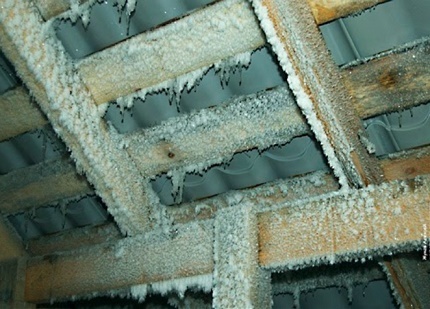
The desire to save money, for example, on insulating a duct or installing a fan leads to low system efficiency and condensation problems, which are extremely problematic to eliminate.
Natural ventilation of the attic floor through the gables will work efficiently if there is a tangible difference between the atmospheric pressure outside the structure and inside. In this case, you can even build a channel from a corrugated pipe with minimal or no insulation: it is cheaper and easier than using conventional pipes or flat channels.
Sidebar option exhaust wall damper or just a ventilation window for a residential attic, we do not consider, since it implies the circulation of cold air directly through the room, from the inlets to the exhaust. This scheme is unacceptable for a heated room: the heat will simply blow out.
Ventilation outlet through the roof
This is the solution that heating engineers advise. And not at all because they want to get more money from you. The fact is that each horizontal pipe section reduces natural draft, which means ventilation efficiency.
It is better to entrust the design of the ventilation shaft of a private house and its exit to the roof to the builders: here it is not only the cross-sectional area and the height above the roof that matter. The area and type of premises, material and shape of the channel, type of ventilation, pipe insulation, temperature in the attic, weather conditions and other factors are important.
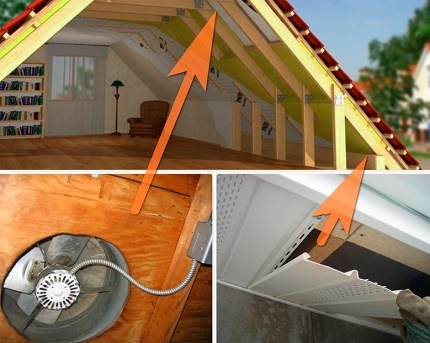
For full ventilation of the attic, an air exchange device within the room and removal of moisture from the roofing cake is required
A vertical pipe brought to the roof will save the owner of the house from problems with condensation in the attic and on the facade, and the deflector or rooftop a fan mounted on the top of the pipe will provide the required level of thrust.
Arrangement passage through the already assembled roof - this is not an easy, costly and ungrateful business, therefore it is better to provide for a ventilation outlet on the roof even at the stage of its construction.
Air exchange in a cold attic
In most cases, the shape of the attic room does not repeat the shape of the base of the sloping roof, because it will not be easy to equip such a non-standard room and make it comfortable. After sheathing the vertical racks of the rafter frame and crossbars from the inside, triangles always remain separated from the usable area.
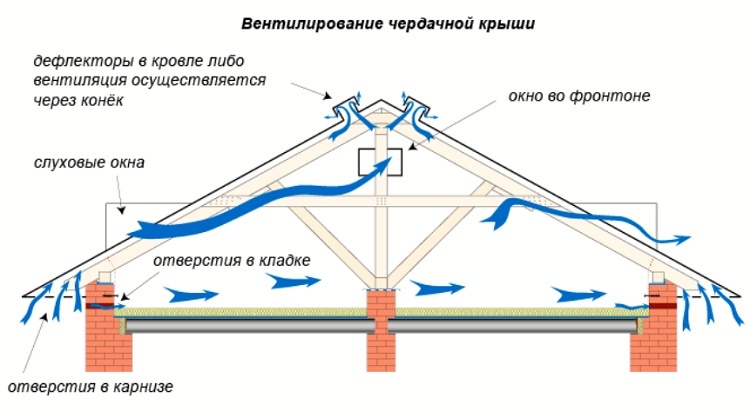
The organization of regular air exchange is necessary not only for attics, but also for cold attics that are not equipped for permanent or temporary residence.
It is not difficult to solve the problem: it is enough to install ventilation grilles, dormer windows, air inlets or front ventilation outlets on each pediment so that the air can penetrate through every cold triangle.
Don't be confused heat loss: they will be minimal, but you will prevent the appearance of mold and musty odors on the walls and ceiling of the attic, not to mention the safety of the roof and ceilings.
How to choose how to close the ventilation holes of the cold triangles above the attic and on the sides of it? In this case, ventilation supply and exhaust valves are rarely used: they are more expensive and their area is relatively small, and in noise absorption there is no need here.
Front ventilation outlets are distinguished by the presence of a canopy that reliably protects against snow and slanting rain. Check valves must be removed or perforated from them, so that when the wind changes, the supply and exhaust openings can change roles.
Ventilation grilles and skylights essentially differ only in size and shape. The possibility of adjusting the opening of blinds and swing doors is useless here.
Competently arranged attic roof
In modern construction, they try to provide maximum thermal insulation, sealto reduce heat loss. The structures that enclose the attic, this concerns, perhaps, most of all. After all, it is through the roofing system that the greatest amount of heat is able to leave.
If the layers of hydro, steam and thermal insulation in the roofing cake are folded without ventilation gaps, the insulation system will practically not work. Moisture that falls out in the form of condensation due to temperature differences, household fumes, rainwater that has penetrated under the roof will not be able to escape.
Water is an excellent conductor, because of its content in the insulation, heat waves will freely pass into the street. In addition, it provokes rotting wood, from which the rafter frame is made, and often the attic sheathing.
Draining a roofing cake is perhaps a separate large topic. However, its effectiveness significantly affects the microclimate of the attic, especially in the summer heat, when the upper layer of the roof warms up to +1000WITH. Therefore, we will briefly talk about how this should be arranged.

With the proper organization of the roofing cake, with the device of ventilation ducts of the required section, the insulated slopes are regularly washed with air flows. As a result, the dried roof does not allow heat waves to pass through, building structures do not get wet and do not fail.
The purpose of any roof ventilation device is to ensure the movement of air from the overhangs to the ridge. The easiest way is to arrange this under a slate roof or ondulina: under the waves of the roofing material, the air rises freely to the ridge, in this case, the overhangs are not tightly hemmed.
WITH metal roofing and corrugated board the situation is almost the same, but it is advisable to equip their cornices with ventilation grilles or close them with an air-permeable seal. The embossed roof must be separated from the waterproofing with a distance bar - it forms the ventilation gap required to remove vapors and atmospheric water accumulated under the coating.
Other materials, in particular, soft tiles or sheet metal, need to artificially create 1 or even 2 ventilation layers of 3 - 5 cm, separating vapor barrier from the insulation, and the waterproofing film - and from the coating.
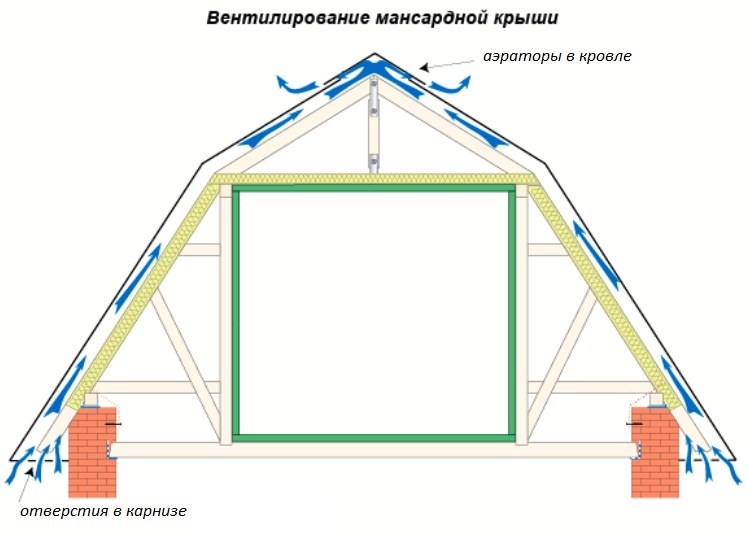
For the inflow and outflow of air flows into the roofing system, openings must be provided to allow the flow to move freely.
Ventilation ducts for this are arranged by laying the lathing and counter-lathing. Air will rise between the grates. If the thickness of the rafters is not enough to lay all the layers of the roofing cake and provide ventilation gaps, the rafter legs are built up with bars.
For inflow into filing eaves use perforated inserts - soffits or ventilation grilles, at regular intervals along the entire length of the overhang. For the hood, a special ridge with aeration or point aerators are installed.
The total cross-sectional area of all holes for ventilation of the roof space should be 1m2 for every 300 - 500m2 the area of the roof slopes.
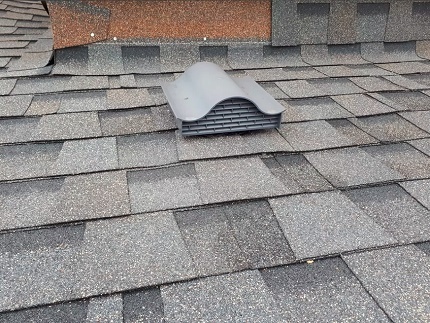
Both the under-roof space and the gable trim can be ventilated through point aerators if the organization of long aerators or slots is not possible.
Ventilation of the gables is carried out between the battens and the facade cladding material. If the sheathing is installed horizontally, then the supports of the lathing are vertical, and they do not interfere with natural ventilation.
If the frame slats need to be fixed horizontally, there are several options for ventilation of the pediment:
- Fasten small pieces of battens horizontally in a checkerboard pattern. This is economical and efficient, but it can be difficult to level everything up.
- Install long slats, but make holes in them in a checkerboard pattern.
- Build a vertical counter batten. Ventilation in this case will be the most effective, but the material will be required the most.
If the sheathing is diagonal, the vertical arrangement of the slats should be preferred.
Conclusions and useful video on the topic
We examined the principles and theory of attic ventilation in detail in the article, and you can clearly get acquainted with the process of installing attic ventilation in the following videos.
Ventilation of cold triangles through the facade ventilation outlets:
How to design dormer to install a skylight in the roof:
How to arrange the ventilation of the attic yourself:
Summing up, we recall that it is equally important to equip ventilation not only of the living space of the attic, but also of the cold attic triangles, and the roof itself. Otherwise, problems can arise both with the comfort of the room and interior decoration, and with the durability of the roof.
Have you already installed ventilation in the attic? Did you manage to set up an effective system on the first try? Share your experience, tips and additions to the article in the comments below.
